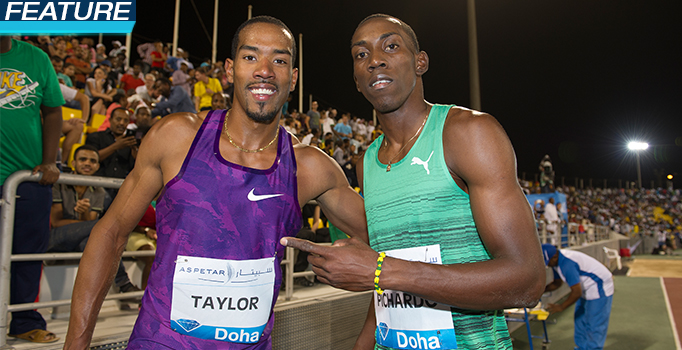GAfter an evening in which Christian Taylor and Pedro Pablo Pichardo reprised their Doha heroics in the triple jump, and surprise Olympic champion Keshorn Walcott took his turn to surprise again in the javelin, the phenomenon might be summed up in one word – synergy.
Or if you prefer, Cometh the Hour, Cometh the Men…
Before this season began, Taylor – a 25-year-old from Fayetteville, Georgia – had won world and Olympic titles in the triple jump.
But he had never entered the 18-metre territory into which only three men had previously ventured – Britain’s world record-holder Jonathan Edwards, Kenny Harrison, the US winner of the 1996 Atlanta Olympic title, and most recently France’s Teddy Tamgho, who reached 18.04m in winning world gold in Moscow two years ago.
In the space of the past two months, however, Taylor has registered three 18-metre-plus jumps. And if one seeks a reason why, there is a three-word answer: Pedro Pablo Pichardo.
This 22-year-old from Santiago de Cuba announced his arrival in the event’s elite at the IAAF Diamond League meeting in Doha on 15 May, where he won the event with an effort of 18.06m that prompted a huge response from his US rival in the last round.
Although Taylor fell just two centimetres short of the Cuban on that occasion, the template was set. And as the events at the most recent IAAF Diamond League meeting demonstrated again, these two young talents are now set to take the event further into the territory which leads to Edwards’ 20-year-old world record of 18.29m in the course of this, and the next, season.
The pattern of the two rivals’ competition in Lausanne matched that of Doha, with Pichardo establishing himself in the lead with a colossal jump, and the US athlete seeking to match it. This time, however, Taylor managed to overtake the Cuban’s seemingly unchallengeable leading mark of 17.99m as he registered 18.02m and 18.06m with his two final efforts as the stadium cooled from the heat of the day.
Taylor reflected with satisfaction afterwards at the way in which he has stepped up his level of performance this season.
“Two jumps over 18 metres means I am getting more consistent at high levels,” he said. “The goal right now is to keep on improving and to keep the triple jump as an exciting event this year.”
He added that he now has his eye on the US record of 18.09m set by Harrison in Atlanta, indicating that it might be something to be attempted as soon as his next scheduled competition, which will be at the IAAF Diamond League meeting in Monaco on 17 July.
Reflecting on the growing rivalry between himself and his US opponent on the eve of the Lausanne meeting, Pichardo commented: “The competition with Christian (Taylor) is a very positive thing, it helps both of us. But having a lead over him is a good thing to have – and I want to remain in the lead.”
The Cuban still is in the lead, thanks to the 18.08m he recorded in Havana less than a fortnight after his competition in Doha. But it’s close. And in terms of 18-metre jumps, Taylor now leads him 3-2 (even though Pichardo’s best effort in Lausanne was only a centimetre short of that mark).
The triple jump thus finds itself supercharged by a new sense of competition and potential achievement, in the same way that the men’s high jump has intensified over the past two years given the presence of two prime performers in the shape of Ukraine’s world champion Bogdan Bondarenko and Qatar’s world indoor champion Mutaz Essa Barshim.
It is a phenomenon which has spread this season to the men’s javelin, where three men are currently reaching peaks of achievement – the Czech Republic’s consistent world champion Vitezslav Vesely and the more mercurial talents of Walcott and Kenya’s Julius Yego, who threw 91.39m to win at the Birmingham IAAF Diamond League meeting on 7 June.
Can the men’s triple jump continue to match these two other field event growth areas?
The answer to that question was obvious from the way in which Taylor’s habitually blithe expression darkened in concentration as he lined up for his penultimate jump. And in the ferocity of Pichardo’s stare at the officials after his own huge fifth-round response had been ruled as a foul.
Of course, this sporting synergy is not confined to men’s field events; the historical precedents are legion. And while having three ‘hot’ performers is good for any event, the essential factor more often than not is to have just two who push and goad and prod each other on to greater achievements.
The classic example is Seb Coe and Steve Ovett rewinding and erasing each other’s world records in the 800m, 1500m and mile during the late 1970s and early 1980s.
But the pattern is a classic. Forty years earlier two Swedes, Gunder Haag and Arne Andersson, did the same thing as they each set three world records for the mile.
The difference was that Haag and Andersson would do so while competing together, while Coe and Ovett remained mysteriously apart until compelled into the same arena by Olympic or European considerations.
Right now, though, there is a common theme which runs through any interviews with high jumpers, javelin throwers and triple jumpers. And that is how much they gain from each other’s challenge.
The bonus, the sport’s spectators, is that those challenges continue to occur within the same competitions. It’s all good.
Mike Rowbottom for the IAAF and the IAAF Diamond League






